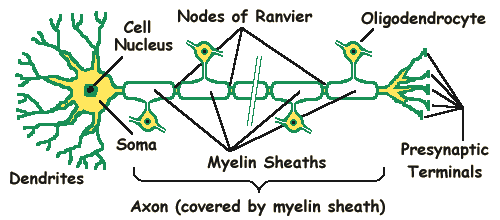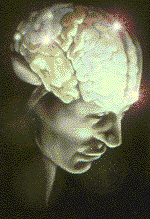Neurotransmitters are small molecules whose function is to transmit nerve signals (impulses) from one nerve cell (neuron) to another. Neurotransmitters are chemical messengers which neurons use to tell other neurons that they have received an impulse. There are many different neurotransmitters - some trigger the receiving neuron to send an impulse and some stop it from doing so. See this simplified diagram of a neuron:

Nerve impulses always flow in one direction - from the branched extensions called dendrites, down the neuron to the presynaptic terminals. The join between the presynaptic terminals of one neuron and the dendrites of another is called the synapse.
The two neurons do not actually touch each other but are separated by a space called the synaptic cleft.
When a nerve impulse arrives at a presynaptic terminal it causes neurotransmitters to be released into the synaptic cleft. The neurotransmitters then bind with special "postsynaptic receptors" in the dendrites of the receiving neuron.
When a postsynaptic receptor receives a neurotransmitter it can either cause a nerve impulse to travel down the neuron or it can inhibit a nerve impulse depending on the neurotransmitter released.
Neurotransmitters which propagate nerve impulses in the receiving neuron are called excitatory neurotransmitters. Those which inhibit nerve impulses are called inhibitory neurotransmitters.
Neurotransmitters are sythesized in the cell body (the soma) and migrate down the axon to the presynaptic terminals. Here they are stored in little packets called vesicles which fuse with the synaptic membrane. When a depolarizing current (the action potential) is received, these vesicles release their contents into the synaptic cleft.
Neurotransmitters activate receptors by "sticking" to them and thus preventing other neurotransmitters from activating them. Inactivation of the transmitter happens in one of three ways:
- Reabsorption of the neurotransmitter into the neuron. This is known as reuptake.
- Destruction of the neurotransmitter with special chemicals called enzymes. This is known as enzymatic degradation.
- By the neurotransmitter becoming deteched from the receptor and drifting out of the synaptic cleft. This is known as diffusion.
Substances that effect neurotransmission but are not neurotransmitters can be broadly divided into two categories - agonists and antagonists.
Agonists make transmission of nerve impulses more likely. They do this in a number of ways including preventing reuptake (cocaine works this way).
Actually triggering the receptor themselves (nicotine works this way)
And by making the receptor more responsive (a lot of anti-anxiety drugs work like this).
Antagonists do the opposite - they interfere with nerve transmission across the synapse sometimes by blocking receptor sites (many spider and snake venoms work this way)
And sometimes by preventing release of the neurotransmitter from the presynaptic terminal (many anti-psychotic drugs operate like this).
The following is an partial list of neurotransmitters, together with the sites in which they work:
Neurotransmitters
| Group |
Neurotransmitter |
Region of Operation |
| Acetylcholine |
Acetylcholine |
Central Nervous System (CNS),
Peripheral Nervous System (PNS) and
Autonomic Nervous System (ANS)
|
| Serotonin |
SerotoninCNS and PNS |
| Amino acids |
Glutamate,
GammaAminobutyric Acid (GABA),
Glycine, Aspartate
|
CNS |
| Histamine |
Histamine |
Hypothalamus |
| Catecholamines |
Norpinephrine, Epinephrine (Adrenalin) |
CNS and Sympathetic Nervous System |
| Neuropeptides |
Endorphins (Enkephalins and Dynorphins), Substance P |
CNS |
| Dopamine |
Dopamine |
CNS |
| Nucleotides |
Adenosine, Adenosine Triphosphate (ATP) |
CNS, PNS and ANS |
| Nitric oxide |
Nitric oxide |
CNS |


